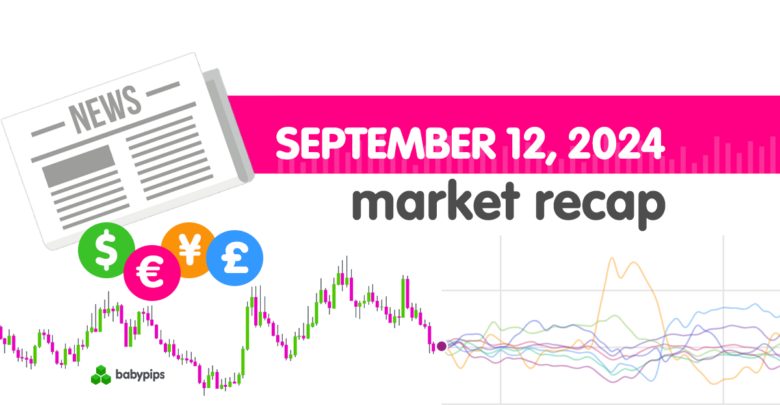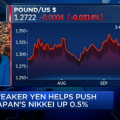It was a risk-on day for financial markets, as crude oil closed out with nearly a 3% win while gold hit fresh record highs.
U.S. stock traders also had a blast, as the S&P and Nasdaq chalked up their fourth consecutive day in the green.
Check out the latest headlines!
Headlines:
- Japan’s producer price index slowed from 3.0% year-on-year in July to 2.5% in August vs. 2.8% forecast
- Japanese BSI manufacturing index improved from -1.0 to +4.5 vs. +2.5 forecast in August
- Australia’s August MI inflation expectations dipped from 4.5% to 4.4% for the next 12 months
- ECB lowered main deposit rate by 0.25% as expected, downgraded growth forecasts while upgrading estimates for core inflation
- During the presser, ECB head Lagarde stressed their data-dependent approach, cited they are looking at a wide range of inflation indicators and plans to keep rates “sufficiently restrictive”
- Canada’s building permits jumped 22.1% month-on-month in July vs. 6.5% forecast, previous reading upgraded from -13.9% to -13.0%
- IEA cut its 2024 demand growth forecasts over weaker Chinese and global demand
- Crude oil prices on the rise as Hurricane Francine weighs on production along the Gulf of Mexico
- U.S. headline PPI rose 0.2% m/m in August (0.1% expected, previous figure downgraded to flat reading); core PPI posted 0.3% m/m uptick (0.2% expected, previous reading lowered from 0.0% to -0.2%)
- U.S. initial jobless claims for the week ending Sept. 6: 230K (227K estimate, 228K previous)
- Oracle shares surged to record highs on AI demand estimates, extending its post-earnings rally; tech sector giants (Nvidia, Metal, and Alphabet) up roughly 2%
Broad Market Price Action:
Dollar Index, Gold, S&P 500, Oil, U.S. 10-yr Yield, Bitcoin Overlay Chart by TradingView
Majority of the asset classes were off to a lazy start, with the exception of bitcoin and crude oil which kicked the day off in rally mode.
The energy commodity drew strong support from resurfacing supply concerns, as Hurricane Francine disrupted more than 40% of production operations along the U.S. Gulf of Mexico, shrugging off downgraded IEA global demand forecasts.
Meanwhile, U.S. equity futures moved mostly sideways during the first couple of trading sessions but stayed in the green throughout the day. Stronger than expected U.S. PPI figures led to a slight dip, but the tech sector rally led by the likes of Oracle, Nvidia, and Meta allowed indices to chalk up their fourth consecutive day in positive territory.
Gold prices also popped sharply higher, reaching new all-time highs at $2,556.86 per ounce, likely bolstered by September Fed rate cut hopes, as FOMC officials could still be debating between a 0.25% or a 0.50% reduction in U.S. borrowing costs.
FX Market Behavior: U.S. Dollar vs. Majors:

Overlay of USD vs. Major Currencies Chart by TradingView
Volatility was already in play for dollar pairs from the get-go, as traders probably continued to adjust positions after the previous session’s U.S. CPI release.
USD/JPY started the day off with a sharp pop higher and proceeded to stay in the green until the London market hours, before taking a turn lower during the U.S. session. AUD/USD and NZD/USD also caught some risk-on gains during the Tokyo session but pulled back from these rallies before picking up steam for the rest of the day.
The ECB decided to lower borrowing costs by 0.25% as expected while downgrading growth forecasts, but this dovish announcement didn’t derail EUR/USD from its ongoing climb. After all, the central bank also made slight upgrades to its core inflation estimates while ECB head Lagarde reiterated their data-dependent approach.
Stronger than expected headline and core PPI from the U.S. economy couldn’t save the dollar from its selloff, although USD/JPY and USD/CHF still put up a fight before eventually caving to dollar weakness.
USD/CAD managed to stay in positive territory, though, likely as the Bank of Canada’s (BOC) inclination for more easing prevented the Canadian currency from taking advantage of crude oil rallies and risk appetite.
Upcoming Potential Catalysts on the Economic Calendar:
- Eurozone industrial production at 9:00 am GMT
- Canada’s wholesale sales and capacity utilization rate at 12:30 pm GMT
- U.S. import prices at 12:30 pm GMT
- U.S. preliminary UoM consumer sentiment index at 2:00 pm GMT
- Chinese industrial production, retail sales and fixed asset investment at 2:00 am GMT (Sept. 14)
Markets could be in for a quiet start on the lack of data flow towards the end of the week, but the U.S. preliminary UoM consumer sentiment index a.k.a. leading indicator of spending could still spark big moves among dollar pairs and the stock market.
Make sure you keep an eye out for China’s data dump over the weekend since these figures could impact the market mood early next week.
Don’t forget to check out our brand new Forex Correlation Calculator!


